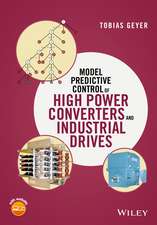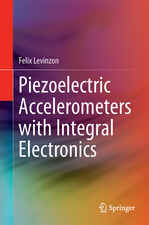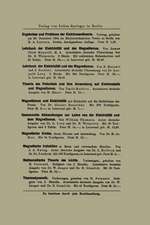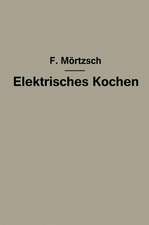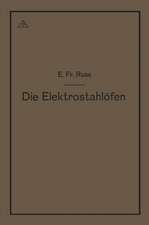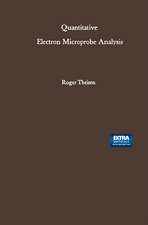Finite Element Analysis of Electrical Machines: Power Electronics and Power Systems
Autor Sheppard J. Salonen Limba Engleză Hardback – 31 iul 1995
Audience: A valuable reference source for academic researchers, practitioners and designers of electrical machinery.
| Toate formatele și edițiile | Preț | Express |
|---|---|---|
| Paperback (1) | 942.94 lei 43-57 zile | |
| Springer Us – 30 sep 2012 | 942.94 lei 43-57 zile | |
| Hardback (1) | 949.55 lei 43-57 zile | |
| Springer Us – 31 iul 1995 | 949.55 lei 43-57 zile |
Din seria Power Electronics and Power Systems
- 18%
 Preț: 944.19 lei
Preț: 944.19 lei -
 Preț: 487.37 lei
Preț: 487.37 lei - 20%
 Preț: 630.01 lei
Preț: 630.01 lei - 15%
 Preț: 648.56 lei
Preț: 648.56 lei - 15%
 Preț: 643.84 lei
Preț: 643.84 lei - 18%
 Preț: 1113.89 lei
Preț: 1113.89 lei - 18%
 Preț: 1120.99 lei
Preț: 1120.99 lei - 18%
 Preț: 950.33 lei
Preț: 950.33 lei - 18%
 Preț: 1981.53 lei
Preț: 1981.53 lei - 15%
 Preț: 638.43 lei
Preț: 638.43 lei - 18%
 Preț: 1660.95 lei
Preț: 1660.95 lei - 18%
 Preț: 940.87 lei
Preț: 940.87 lei - 15%
 Preț: 637.46 lei
Preț: 637.46 lei - 18%
 Preț: 953.65 lei
Preț: 953.65 lei - 18%
 Preț: 953.97 lei
Preț: 953.97 lei - 18%
 Preț: 944.67 lei
Preț: 944.67 lei - 15%
 Preț: 634.32 lei
Preț: 634.32 lei - 18%
 Preț: 832.78 lei
Preț: 832.78 lei - 18%
 Preț: 945.30 lei
Preț: 945.30 lei - 18%
 Preț: 1239.85 lei
Preț: 1239.85 lei - 15%
 Preț: 642.18 lei
Preț: 642.18 lei - 18%
 Preț: 1656.08 lei
Preț: 1656.08 lei - 18%
 Preț: 953.65 lei
Preț: 953.65 lei - 18%
 Preț: 1554.09 lei
Preț: 1554.09 lei - 18%
 Preț: 1657.03 lei
Preț: 1657.03 lei - 18%
 Preț: 951.47 lei
Preț: 951.47 lei - 18%
 Preț: 888.31 lei
Preț: 888.31 lei - 18%
 Preț: 1219.01 lei
Preț: 1219.01 lei - 18%
 Preț: 893.53 lei
Preț: 893.53 lei - 18%
 Preț: 942.94 lei
Preț: 942.94 lei - 18%
 Preț: 1110.24 lei
Preț: 1110.24 lei - 15%
 Preț: 641.85 lei
Preț: 641.85 lei
Preț: 949.55 lei
Preț vechi: 1157.98 lei
-18% Nou
Puncte Express: 1424
Preț estimativ în valută:
181.75€ • 197.49$ • 152.77£
181.75€ • 197.49$ • 152.77£
Carte tipărită la comandă
Livrare economică 21 aprilie-05 mai
Preluare comenzi: 021 569.72.76
Specificații
ISBN-13: 9780792395942
ISBN-10: 0792395948
Pagini: 247
Ilustrații: XI, 247 p.
Dimensiuni: 155 x 235 x 21 mm
Greutate: 0.56 kg
Ediția:1995
Editura: Springer Us
Colecția Springer
Seria Power Electronics and Power Systems
Locul publicării:New York, NY, United States
ISBN-10: 0792395948
Pagini: 247
Ilustrații: XI, 247 p.
Dimensiuni: 155 x 235 x 21 mm
Greutate: 0.56 kg
Ediția:1995
Editura: Springer Us
Colecția Springer
Seria Power Electronics and Power Systems
Locul publicării:New York, NY, United States
Public țintă
ResearchCuprins
1 Introduction to Finite Elements.- 1.1 Introduction.- 1.2 The Galerkin Finite Element Method.- 1.3 Boundary Conditions.- 1.4 Magnetostatic Example.- 2 Nonlinear Problems.- 2.1 Introduction.- 2.2 Representation of the B-H Curve.- 2.3 The Basic Newton-Raphson Method for a Single Equation.- 2.4 Application of the Newton-Raphson Method to a First Order Element.- 2.5 Cubic Splines.- 3 Permanent Magnets.- 3.1 Introduction.- 3.2 Magnetization Models of Permanent Magnets.- 3.3 Current Sheet Equivalents.- 3.4 Example With Permanent Magnet.- 3.5 Intrinsic and Normal Hysteresis Characteristics.- 4 Eddy Current Analysis.- 4.1 Introduction.- 4.2 Eddy Currents and Skin Effect.- 4.3 Finite Element Example.- 4.4 Elliptical Description of Flux Density.- 4.5 Eddy Currents In Nonlinear Materials.- 4.6 Nonlinear Permeability Models.- 4.7 Coupling Finite Elements To External Circuits.- 4.8 Numerical Example.- 4.9 Modeling Considerations.- 5 Computation of Losses, Resistance and Inductance.- 5.1 Introduction.- 5.2 Computation of Eddy Current Loss.- 5.3 Losses In A Series Winding.- 5.4 Inductance and Reactance.- 5.5 Poynting Vector.- 5.6 Nonlinear Problems.- 6 Calculation Of Force And Torque.- 6.1 Introduction.- 6.2 Ampere’s Force Law.- 6.3 The Maxwell Stress Method.- 6.4 The Virtual Work Method.- 6.5 Using Machine Models to find Torque.- 6.6 Errors in Force Computation.- 6.7 Convergence of Force.- 7 Synchronous Machines in the Steady State.- 7.1 Introduction.- 7.2 The Basic Configuration of a Synchronous Machine.- 7.3 Steady State Operation — Excitation Calculation.- 7.4 Modeling Considerations.- 7.5 Excitation Calculation.- 7.6 Computation of Steady State Reactances.- 7.7 Direct Axis Transient Reactance, X?d.- 7.8 Direct Axis Subtransient Reactance, X?d.- 7.9 Frequency Response Curves.- 7.10 Time Constants.- 7.11 Poynting Vector Method.- 8 The Induction Motor in Steady State.- 8.1 Introduction.- 8.2 Obtaining Steady State Parameters.- 8.3 Obtaining Reactances From The Frequency Response.- 8.4 Results.- 8.5 Using Frequency Domain Data With Time Domain Solutions.- 9 Time Domain Modeling of Induction Machines.- 9.1 Introduction.- 9.2 Electromagnetic and Mechanical Theory.- 9.3 Galerkin Formulation.- 9.4 Time Discretization.- 9.5 Linearization.- 9.6 Global System of Equations.- 9.7 Examples.- 10 Air-Gap Elements for Electrical Machines.- 10.1 Introduction.- 10.2 Description of the Method.- 10.3 Application.- 11 Axiperiodic Solutions.- 11.1 Introduction.- 11.2 Finite Element Formulation for Scalar Fields.- 11.3 Calculation of Steady State Forces.- 11.4 Calculation of Transient Forces.



